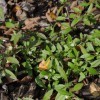Abstract
Eclipta grows aggressively in containers and can outcompete nursery crops for water, nutrients, and light. Plants flower in as little as five weeks after germination and produce thousands of seeds over the course of a growing season, and stem fragments left on the soil or media surface following hand-weeding or cultivation can root and reproduce vegetatively. This 4-page fact sheet describes the plant, its biology, and recommendations for physical, cultural, and chemical control. Written by Chris Marble, Shawn Steed, and Nathan S. Boyd, and published by the UF Department of Environmental Horticulture, January 2015. (Photo: Annette Chandler, UF/IFAS)
References
Cochran, D. R., C. H. Gilliam, D. J. Eakes, G. R. Wehtje, P. R. Knight, and J. Olive. 2009. "Mulch Depth Affects Weed Germination." J. Environ. Hort. 27:85-90. https://doi.org/10.24266/0738-2898-27.2.85
Gupta, P. L. 1992. "Seed Germination Study of Eclipta prostrata Linn." Advances in Plant Sciences 5:187-189.
Holm, L. G., J. V. Poncho, J. P. Herberger, and D. L. Plunknett. 1979. A Geographical Atlas of World Weeds. New York: John Wiley and Sons.
Prostko, E. P. 2012. "Eclipta Identification and Control in Peanut." Circular 869. Athens, GA: University of Georgia Coop. Extn..
Neal, J. C. and J. F. Derr. 2005. Weeds of Container Nurseries in the United States. Raleigh, NC: North Carolina Assoc. of Nurserymen, Inc.
USDA National Resources Conservation Service. 2014. "The PLANTS Database." Greensboro, NC: National Plant Data Team. http://plants.usda.gov.

